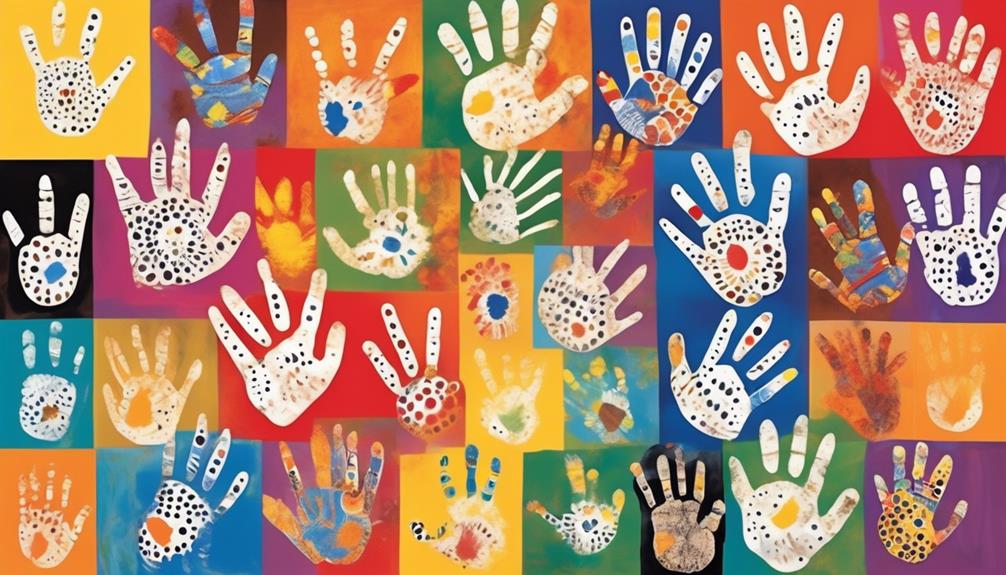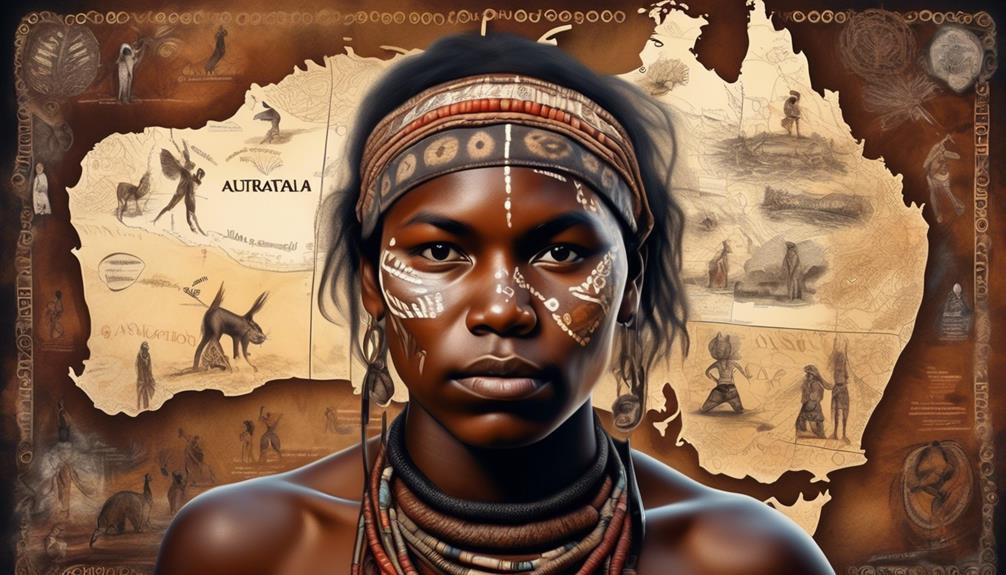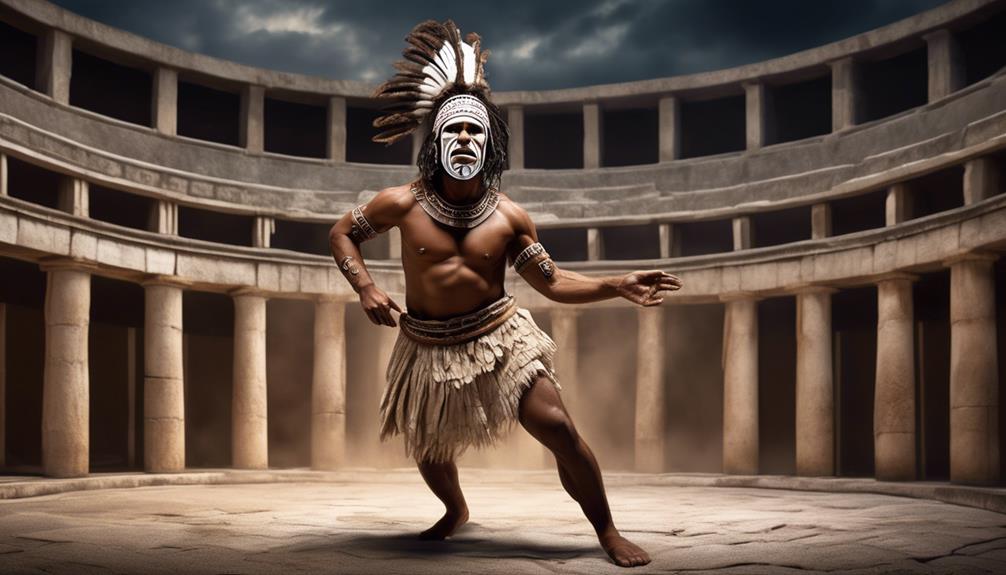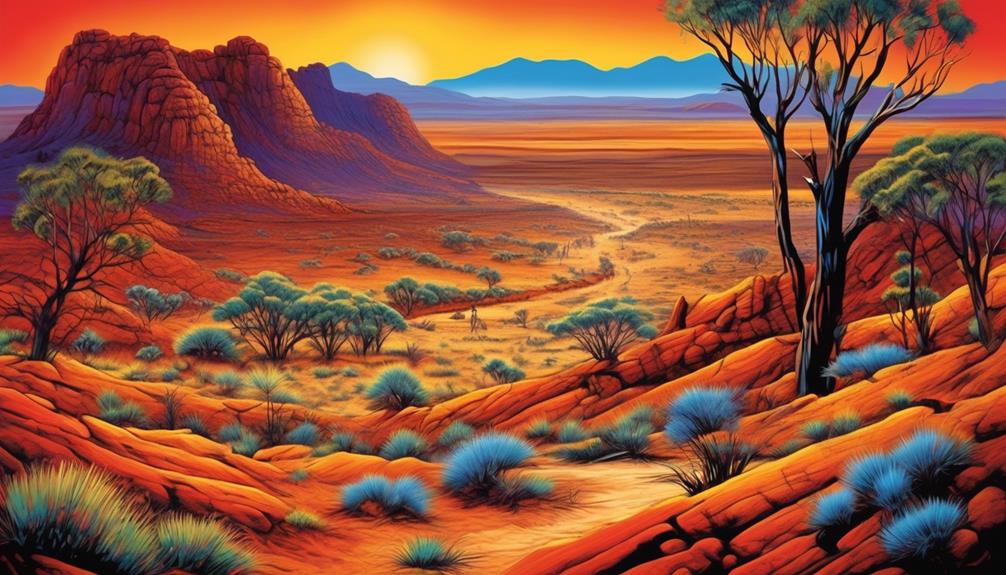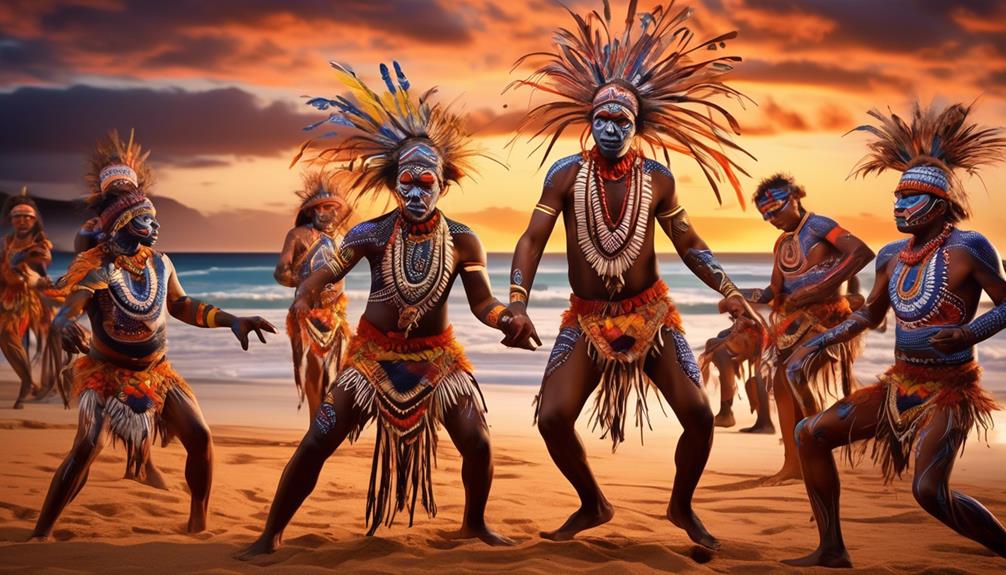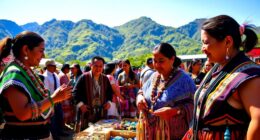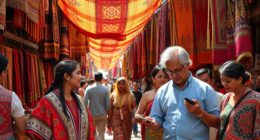Have you ever thought about integrating Indigenous Australian art into your preschool program?
It's a fantastic way to introduce young students to the rich cultural heritage of Indigenous Australians while also encouraging creativity and fine motor skills.
There are several engaging and age-appropriate Aboriginal art ideas that can easily be adapted for kindergarten classrooms. From dot painting with Q-tips to exploring dreamtime storytelling through symbols, the possibilities are both educational and inspiring.
You won't want to miss out on the opportunity to introduce your students to these captivating art forms that celebrate history, tradition, and creativity.
Key Takeaways
- Dot painting with Q-tips is a fun and creative way for kindergarteners to develop fine motor skills and explore Aboriginal art.
- Creating dot paintings allows children to tell their own Dreamtime stories and appreciate the cultural significance of Aboriginal art.
- Handprint boomerang art encourages fine motor skill development and teaches children about the cultural significance of boomerangs in Aboriginal art.
- Making an emu feather collage helps children explore color blending and texture while developing their fine motor skills and understanding of color theory.
Dot Painting With Q-Tips
Get ready to explore the colorful world of dot painting with Q-tips, a fun and easy way for kindergarteners to create their own Aboriginal-inspired art! Dot painting techniques involve using small dots of paint to create intricate patterns and designs. With Q-tip art, children can easily dip the cotton ends of the Q-tips into paint and then dab them onto paper to create beautiful dot patterns. This technique allows for fine motor skill development and encourages creativity.
In Aboriginal culture, dot painting is a form of symbolic storytelling, often depicting Dreamtime myths and the natural world. When introducing this art form to kindergarteners, you can share simple Dreamtime stories to inspire their own dot paintings. Encourage the children to think about the stories they want to tell through their art. They can use different colors and dot sizes to represent elements of their story, fostering imagination and self-expression.
Dreamtime Storytelling With Symbols
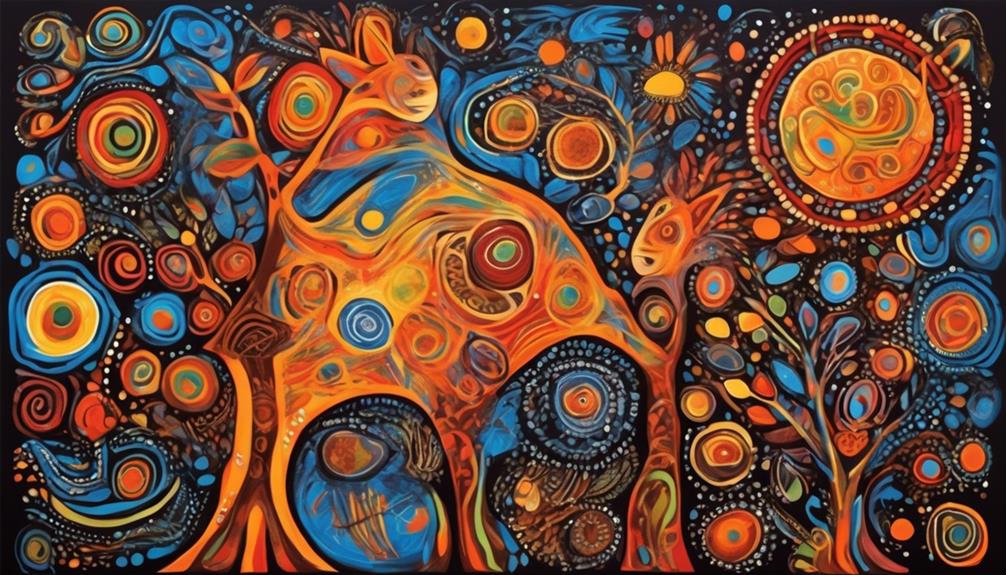
Engage kindergarteners in the captivating world of Aboriginal storytelling by incorporating symbolic symbols and vibrant colors into their dot paintings. Aboriginal culture is rich with Dreamtime stories, which are ancient tales that explain the creation of the world and the rules for living. These stories are often represented through symbolic storytelling, using images that hold deep cultural significance. By introducing kindergarteners to these symbols, you can help them understand cultural representation and the importance of storytelling in Aboriginal communities.
| Symbol | Meaning |
|---|---|
| Sun | Represents warmth, light, and life |
| Water | Signifies life, purity, and renewal |
| Animal Tracks | Depicts the presence of animals and their significance in the Dreamtime stories |
Using these symbols, children can create their own Dreamtime stories through dot paintings. Encourage them to think about the meanings behind each symbol and how they can incorporate them into their artwork. This not only fosters creativity but also helps children develop an understanding and appreciation for Aboriginal culture. Through this activity, kindergarteners can learn about cultural representation while expressing themselves artistically.
Handprint Boomerang Art
Explore the exciting world of Aboriginal art with kindergarteners through the engaging and hands-on activity of creating Handprint Boomerang Art. This activity not only allows children to express their creativity but also introduces them to the cultural significance of boomerangs in Aboriginal art. It's a wonderful opportunity for kindergarteners to learn about and appreciate the artistic traditions of Aboriginal Australians.
- Cultural Significance: Discuss the importance of boomerangs in Aboriginal culture. Explain that they were traditionally used for hunting and had spiritual significance. Encourage children to understand and respect the cultural significance of the boomerang in Aboriginal art.
- Motor Skills: Engage children in the process of creating their handprint boomerangs, which promotes the development of fine motor skills. The activity involves tracing and cutting out their handprints, which enhances their hand-eye coordination and fine motor control.
- Creative Expression: Encourage children to use vibrant colors and patterns in their boomerang designs. This allows them to express their creativity while also learning about the visual elements commonly used in Aboriginal art.
Emu Feather Collage
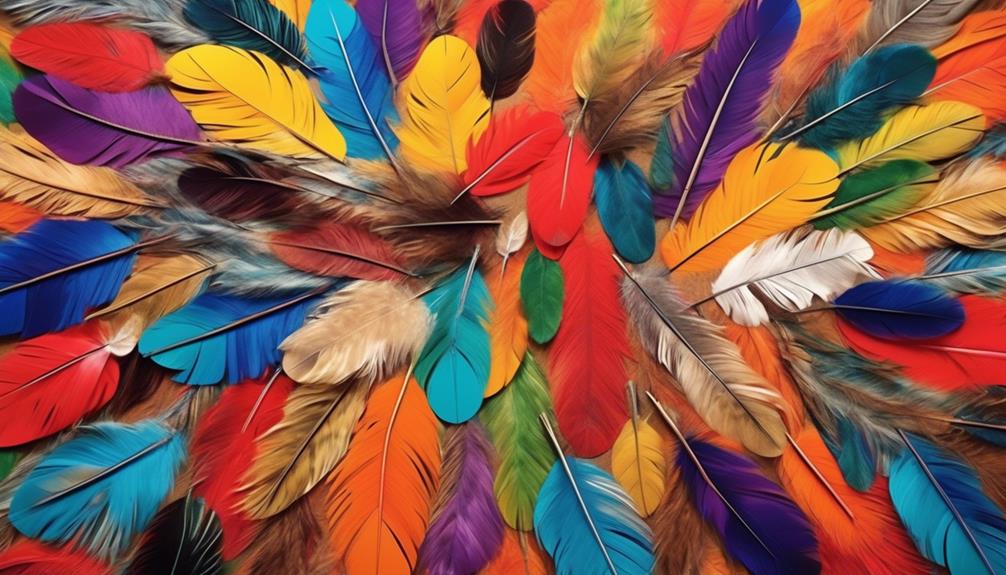
Create a vibrant collage using emu feathers to explore the unique textures and colors found in Aboriginal art.
Emu feathers come in various shades, allowing for beautiful color blending in your collage. This activity provides an exciting opportunity for texture exploration as well.
Start by collecting emu feathers of different colors and sizes. Encourage the children to feel the feathers and notice their softness and flexibility.
Next, provide them with a piece of cardboard or thick paper as the base for their collage. Let the children use child-safe glue to carefully attach the emu feathers to the cardboard, creating their own unique designs.
As they work, prompt them to talk about the colors they're using and how they can blend them together to create new shades.
This activity not only allows children to engage in a fun and creative art project but also helps them develop their fine motor skills and understanding of color theory.
The end result will be a stunning display of colorful emu feather collages that celebrate the beauty of Aboriginal art.
Rock Art Exploration
Discover the ancient art of rock paintings and unleash your creativity through this fascinating exploration of Aboriginal rock art. Rock art interpretation provides a window into the lives and beliefs of Indigenous Australians, and it's a wonderful way to connect with their culture.
Here's how you can dive into rock art exploration:
- Outdoor Nature Exploration: Take a nature walk to find rocks and natural pigments like clay and ochre. Encourage children to observe the textures and colors of the rocks they find, fostering a connection to the natural world.
- Rock Art Interpretation: Show children images of traditional Aboriginal rock art and discuss the stories and meanings behind them. Then, encourage them to create their own rock art, expressing their own stories or interpretations through painting.
- Creative Play: Set up a pretend rock art site where children can use rocks and natural pigments to create their own rock art. This hands-on activity allows them to engage in imaginative play while learning about this ancient art form.
Frequently Asked Questions
How Can I Incorporate Aboriginal Art Into Other Subjects in My Kindergarten Classroom, Such as Science or Math?
To incorporate Aboriginal art into science and math, consider using art to explore patterns in nature or traditional symbols in counting activities. When teaching Aboriginal art, it's important to honor cultural significance and engage in respectful dialogue.
For science, explore natural elements and their representation in art.
In math, use traditional symbols for counting or explore geometric patterns in Aboriginal art.
Always consider the cultural significance and history when incorporating Aboriginal art into other subjects.
Are There Any Specific Cultural Considerations or Protocols I Should Be Aware of When Teaching Aboriginal Art to Young Children?
When teaching young children about Aboriginal art, it's crucial to approach it with cultural sensitivity.
Respect the artistic expression and traditions by learning about specific protocols and considerations.
Engage children in activities that honor and celebrate the rich cultural heritage, fostering a deep appreciation for Aboriginal art.
Encourage exploration of symbols, colors, and storytelling while ensuring that cultural authenticity and respect are at the forefront of the learning experience.
Can You Recommend Any Age-Appropriate Books or Resources for Teaching Kindergarten Students About Aboriginal Art and Culture?
For age-appropriate resources on teaching kindergarten students about Aboriginal art and culture, consider 'Welcome to Country' by Aunty Joy Murphy and 'Respect' by Aunty Fay Muir and Sue Lawson.
These books offer an engaging introduction to Aboriginal culture, fostering cultural sensitivity and respect.
Teaching techniques can include storytelling, dot painting, and exploring traditional symbols.
Art integration can enhance understanding and appreciation of Aboriginal art, creating a meaningful learning experience for young students.
Are There Any Traditional Aboriginal Art Techniques or Materials That Are Not Suitable for Use in a Kindergarten Setting?
When considering traditional Aboriginal art techniques for kindergarteners, safety concerns and cultural appropriateness are vital.
Some traditional materials like toxic natural pigments may not be suitable for young children. However, age-appropriate materials like non-toxic paints and natural fibers can be used to introduce traditional techniques in a safe and culturally respectful way.
It's important to ensure that the activities are both engaging and developmentally appropriate for the children.
How Can I Encourage My Kindergarten Students to Express Their Own Creativity and Interpretations When Creating Aboriginal-Inspired Art?
To encourage creativity and interpretation in art, provide open-ended prompts and materials that allow for exploration and personal expression.
Encourage students to share their thoughts and feelings about their creations, fostering a sense of ownership and pride in their work.
Integrate art into other subject areas, such as storytelling or nature studies, to make cross-curricular connections and inspire diverse perspectives.
Celebrate each child's unique artistic voice to nurture a love for self-expression.
Conclusion
Now that you've explored these Aboriginal art ideas for kindergarten, you're ready to dive deeper into the rich culture and history of Indigenous Australian art. Keep expanding your knowledge and creativity by learning about different techniques and symbols used in Aboriginal art.
Who knows what amazing masterpieces your kindergarten class will create next! Keep exploring and discovering the beauty of Aboriginal art.
Talise is a talented writer and an expert in her field. Her unique perspective and insights enrich our content with depth and authenticity. With a wealth of knowledge and a strong connection to the subjects she writes about, Talise crafts engaging and informative articles that resonate with our readers. Her dedication to bringing Indigenous culture and wisdom to light is truly commendable.
